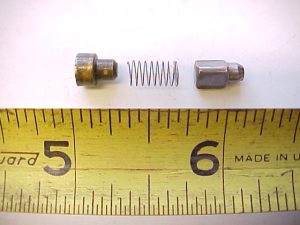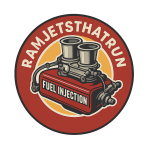I believe GM was very aware of the spider percolation problem in early Rochester FI units. They tried several fixes to eliminate the problem. The first was to isolate the spider from the heat radiating upward from the adapter manifold. In 1957 and most of 1958 fuel injected Corvettes were fitted from the assembly line with a thick, one-piece cardboard gasket / heat shield between the plenum and the adapter manifold. This proved ineffective, so the large gasket wasn’t used on later units. The next cure they tried did have some positive effect on the idle percolation problem, but it also introduced a new problem that wasn’t apparent for several years.
In 1963 the gas feed circuit to the distribution spider was made into a loop. Instead of getting gas that had been through the spill valve, the spider now received only some of the gas from the gear pump while it was on its way to the spill valve. This new design circulated more of the relatively cool gasoline from the fuel meter through the spider hub. I think that’s why the ’63 – ’65 FI units don’t have as bad an idle percolation problem as the pre-’63 units.
The down side of this spider feed loop arrangement is its effect on the spider hub design. The anti-siphon needle valve was gravity operated from 1957 through 1962. In 1963 though, gravity could not be used. The spider hub had been inverted to make more room for the fuel supply loop. This made the hub needle valve “upside-down”. A tiny spring had to be installed below the needle valve to shut it when the engine was turned off. This new spring-loaded needle valve design had an unintended effect: it provided a variable resistance to gas flow into the spider. The more the spring was compressed by gasoline flow, the more backpressure it produced. The previous gravity-operated needle valve had a constant amount of backpressure essentially equal to the weight of the needle valve.
I believe this variable resistance of the spider hub spring was properly considered in the engineering design of the ’63 – ’65 FI units. However, the manufacturer of these tiny springs probably didn’t have good quality control. I believe that many spiders were assembled with springs that had significantly different spring rates than what GM specified. I believe this because about 30% of the ’63 – ’65 spiders that I check flunk one of my driving tests.
I call this my “freefall-to-idle” test. It works like this. [WARNING: Do not try this in your driveway.] After warming up the engine, I stand on the accelerator pedal through three gears. I then suddenly take my foot off the accelerator pedal and disengage the clutch at the same time. This allows the engine speed to freefall from about 5,500 rpm to an 800 rpm idle without any resistance from the drivetrain. At this point the FI system has been running full rich for about ten seconds. It has fully compressed the spider hub needle valve spring during that period. Now the FI system has to immediately create a much leaner mixture. The spring has to extend to the precise location necessary to support an idle. Evidently that’s a hard test for an imperfect spider to pass. If the spring is defective, the resulting idle mixture will immediately be too rich or too lean and the engine will die.

